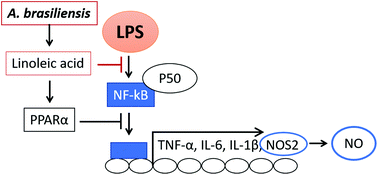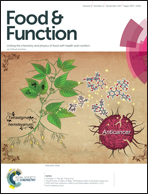The anti-inflammatory effect of Agaricus brasiliensis is partly due to its linoleic acid content†
Abstract
For hundreds of years mushrooms have been used as functional food for health. The basidiomycete Agaricus brasiliensis (A. brasiliensis) is famous for the medicinal properties of its beta glucans and of its antioxidants. Most researchers have studied polysaccharides from A. brasiliensis for their anti-inflammatory activity. However, active compounds from this mushroom have not yet been studied for the inactivation of NO inhibitory activity. The present study aimed to find the active compounds from A. brasiliensis for their NO inhibitory activity related inflammatory activity. This study found that linoleic acid isolated from A. brasiliensis inhibited NO production and suppressed the expression of pro-inflammatory cytokines including TNF-α, IL-6, IL-1β, and NOS2 in RAW 264.7 cells. Linoleic acid also suppressed the expression of NF-κB subunit p50 and restored PPARα. This leads to the conclusion that linoleic acid from A. brasiliensis could reduce NO production and inflammatory activity in RAW 264.7 cells by the inhibition of p50 and via the activation of PPARα. This study suggests that linoleic acid present in A. brasiliensis could play a role in the prevention of inflammatory diseases for which this edible mushroom is already known.



 Please wait while we load your content...
Please wait while we load your content...